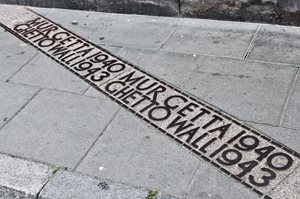
Warsaw’s newest museum is a triumphant monument, not only to a vibrant and important part of Poland’s cultural history, but also to the spirit of cooperation and tolerance of post-Communist Poland. A team of 120 prominent Polish and international scholars worked on the conceptual development of Polin Museum of the History of Polish Jews, under the joint patronage of the Association of Jewish Historical Institute of Poland and the Polish Ministry of Culture. Opened in 2013, the museum quickly became one of the must-see sights of Warsaw.
The museum stands on the sight of the Warsaw ghetto, where half a million of Poland’s 3.3 million Jews were incarcerated during World War II. It was here that one of the few instances of Jewish resistance took place during the four-day uprising of 1943. Carefully integrated into an ensemble with the existing Monument to the Ghetto Heroes, the museum won the prestigious Chicago Athenaeum International Architecture Award in 2008.
Along with its impressive research collections, the museum’s eight galleries plunge visitors into the fascinating thousand-year history of Jews in Poland, using a combination of images, objects, and multimedia and interactive technology, which bring primary sources delightfully to life.
Beginning with the Jews who arrived in Poland during the First Crusade, Polish kings were relatively tolerant of the new wave of immigrants as the Jews brought with them much-needed skills to a land devastated by the Tatar Mongol invasion. This attracted polyglot Jews from all corners of Europe and their dialects soon melded in to the unifying Yiddish, still the
lingua franca of Ashkenazi Jews today. Centuries followed during which Jews enjoyed both freedom of worship and assembly, and Poland became the preeminent center of Talmudic study in Europe. By the 16th century, eighty percent of the Jews in the world lived in Poland-Lithuania and Jewish scholarship flourished in the Polish
yeshivot.
The decline in the fortunes of Poland’s Jews began in the late 18th century during the partition of Poland, which rendered the country a mere vassal state of the mighty Russian empire. Catherine the Great forced the Jews into the Pale of Settlement, greatly restricting their access to university education and many professions. Nevertheless, by 1885, four million Jews lived in Poland. The tragic events of the 20th century, including anti-Semitic legislation, the Holocaust, and the Communist era reduced the number of Polish Jews to a mere twenty thousand, only .06% of Poland’s population.
Poland’s commitment to preserving this unique history is a boon to all visitors to Warsaw. Alexander+Roberts’ own experience in Poland runs deep, dating back to our Polish-born founder
Alexander Harris. We invite you to experience all that Poland and Warsaw have to offer including our small group
Grand Capitals of Eastern Europe by Rail.